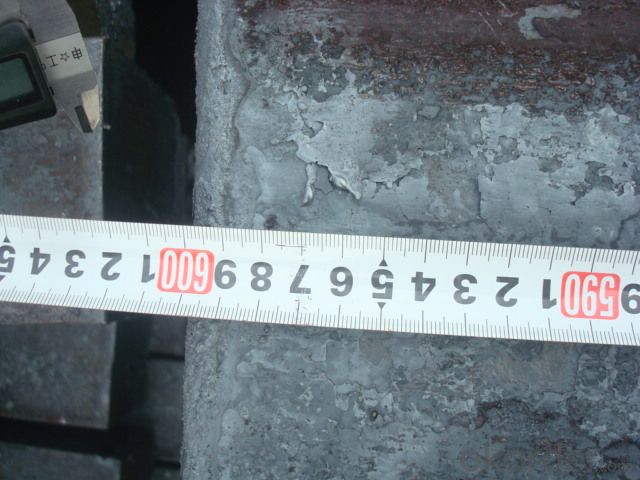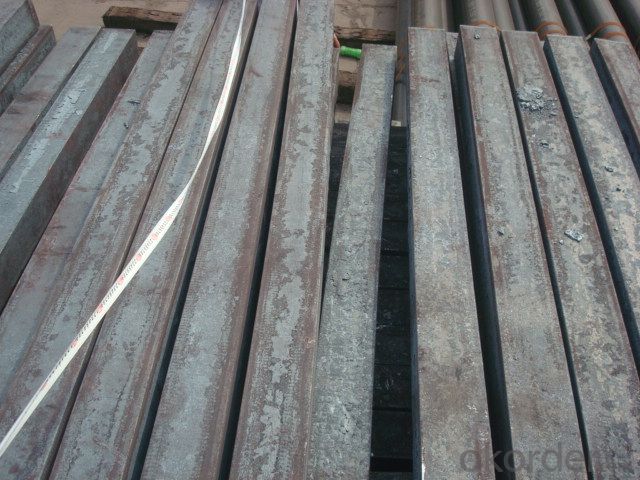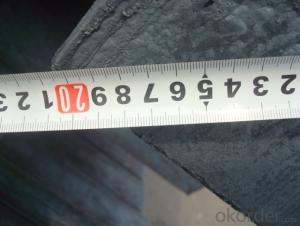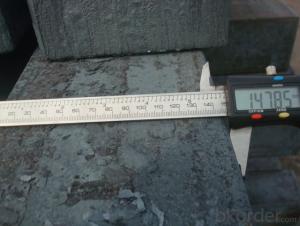Prime Steel Billet Q275, 20MnSi, 5SP,Q235
- Loading Port:
- Tianjin
- Payment Terms:
- TT OR LC
- Min Order Qty:
- 1000 m.t.
- Supply Capability:
- 20000 m.t./month
OKorder Service Pledge
OKorder Financial Service
You Might Also Like
STEEL BILLET
1.Brief description
Steel billet(ingot) by cogging or breakdown of semi-finished products, is the raw material of all kinds of steel mill. Billet section of square, round, flat, rectangular and abnormity of several kinds of, mainly related to the shape of rolled products.
2.Features
Rectangular billet continuous casting billet and mainly general carbon steel, low carbon low silicon cold-rolled material, high quality carbon structural steel, high strength low alloy steel, special steel, etc.
The billet is mainly divided into two kinds from the shape:
Slab: cross section width and height of the ratio of the larger, mainly used for rolling plate.
Billet: equal cross section width and height, or a huge difference, mainly used for rolling steel, wire rod. ,
Steel billets have distinct characteristics as compared with already furnished steel bars and products. Billets have a specific grain structure, which enables the metal to be processed more intricately. Steel billets are also known for their malleability and ductility, especially when exposed to varying temperatures during shaping and molding.
3.Processing
Steel billets are considered fresh and raw, and they must undergo a series of manufacturing processes before they can be used for various purposes. Billets are made by means of freezing molten liquid, and are later exposed to extremely low temperatures in order to allow the metal to take shape and solidify in chemical structure. The temperature manipulates the metal's physical properties, and tones its strength and durability. The subsequent processes provide the metal's curved mold design so that it can fit the allotted space provided by other machines, which complete the finishing procedures.
4.Pictures


5.Usage
Billets, or ingots (as they sometimes referred to), are not of practical use until they have been formed into more functional shapes and sizes. While they have already been put in the furnace, they still require a series of shaping and molding procedures such as hot and cold working, milling and cutting before they are sold in hardware stores, or used for different applications. The unformed billets, however, can be used in striking currency such as coins and as reserves, similar to gold bars.
6.Detailed specification
Hot rolled billet steel
Size: 50x50mm-180x180mm
Steel Grade: 3SP, 5SP,Q195,Q235,Q255,Q275 Length:3m-12m
MOQ: 1000MT/size
Payment term: TT or LC
Packing: in bulk , bundle
Shipment: by container , bulk vessel
Packaging Details: bundles with steel strips or as customers's requirements
Delivery time: 15-30 days after the deposit
Loading port:Tianjin, or other port China
Origin : China
Inspection:Third party inspection before loading.
- Q:What does the billet of the steel plant refer to?And steel what is the difference?
- Many species, usually by chemical composition, production process, rolling shape, supply form, diameter, and use in the structure the classification of steel bars for concrete reinforcement refers to straight or strip steel plate reinforced concrete reinforcement steel, its shape is divided into round steel bar and deformed steel two. Steel bars in concrete under tensile stress.
- Q:How are steel billets used in the manufacturing of wire rods?
- Steel billets are an integral part of the manufacturing process for wire rods. These billets, which are essentially semi-finished steel products, serve as the raw material for producing wire rods. The first step in the manufacturing process involves heating the steel billets to a high temperature in a furnace. This process, known as heating or re-heating, helps to soften the steel and make it more malleable. Once the billets are heated, they are then passed through a series of rolling mills. In these mills, the billets are subjected to intense pressure and are gradually shaped into wire rod form. The rolling process elongates the steel billets and reduces their diameter to the desired size. After the initial rolling, the wire rods undergo further processing to enhance their strength, surface finish, and dimensional accuracy. This may involve various techniques such as cooling, heat treatment, and surface conditioning. Finally, the wire rods are cut into specific lengths and undergo quality control checks to ensure that they meet the required standards. They are then ready to be used in various applications such as construction, automotive, and electrical industries. In summary, steel billets play a crucial role in the manufacturing of wire rods. They are heated, rolled, and processed to create wire rods of different sizes and properties. These wire rods are then used in a wide range of industries, making them an essential component in the manufacturing sector.
- Q:What are the main factors affecting the hardenability of steel billets?
- The hardenability of steel billets, or the ability of a steel alloy to be hardened through heat treatment, is influenced by several main factors. These factors include the chemical composition of the steel, the cooling rate during quenching, and the grain size of the steel. Firstly, the chemical composition of the steel plays a crucial role in determining its hardenability. Elements such as carbon, manganese, and alloying elements like chromium, molybdenum, and nickel can significantly affect the hardenability. Higher carbon content increases the hardenability, as does the presence of certain alloying elements. These elements form carbides that enhance the formation of martensite, the hard and brittle phase that gives steel its hardness. The cooling rate during quenching is another critical factor affecting hardenability. Quenching involves rapidly cooling the heated steel billet, typically in a liquid medium such as water or oil. The cooling rate determines the transformation of the steel's microstructure. Faster cooling rates result in a higher degree of hardenability, as they promote the formation of martensite. Slower cooling rates, on the other hand, can lead to the formation of softer phases like ferrite or pearlite. Lastly, the grain size of the steel also influences its hardenability. A smaller grain size provides more nucleation sites for the formation of martensite, leading to improved hardenability. Grain refinement can be achieved through processes such as alloying, heat treatment, and controlled cooling. Additionally, the presence of non-metallic inclusions, which act as stress concentration sites, can also affect the hardenability by promoting crack initiation and propagation during quenching. In summary, the main factors affecting the hardenability of steel billets are the chemical composition of the steel, the cooling rate during quenching, and the grain size of the steel. Understanding these factors and their interplay is crucial for achieving the desired hardness and mechanical properties in steel billets during heat treatment processes.
- Q:What are the main factors that affect the competitiveness of steel billets manufacturers?
- The main factors that affect the competitiveness of steel billet manufacturers include cost of production, quality of products, technological advancements, availability of raw materials, economies of scale, market demand, pricing strategies, and competitiveness of rival manufacturers.
- Q:How are steel billets used in the production of power transmission equipment?
- Steel billets are an essential component in the production of power transmission equipment. Power transmission equipment, such as gears, shafts, and couplings, require high-strength and durable materials to withstand the forces and stresses involved in transmitting power. Steel billets, which are semi-finished steel products, play a crucial role in meeting these requirements. Firstly, steel billets are used as raw material for forging or casting processes to create various components of power transmission equipment. Forging involves heating the billets to a high temperature and then shaping them under extreme pressure, resulting in a strong and dense material with excellent mechanical properties. Casting, on the other hand, involves pouring molten steel into molds to form complex shapes. Steel billets are melted and cast into molds to create intricate components like gears or shafts. Furthermore, the composition and quality of steel billets are carefully controlled to ensure that the final product meets the specific requirements of power transmission equipment. Steel billets are made from various steel grades, each with different properties such as strength, hardness, and wear resistance. The choice of steel grade depends on the specific application and operating conditions of the power transmission equipment. For instance, a gear used in heavy-duty industrial machinery may require a higher strength steel billet compared to a gear used in a smaller-scale application. Additionally, steel billets can undergo further processing, such as heat treatment, to enhance their mechanical properties. Heat treatment processes like quenching and tempering can improve the hardness, toughness, and overall performance of the billets. This ensures that the final power transmission equipment has the necessary strength and durability to withstand the rigors of transmitting power. In summary, steel billets are crucial in the production of power transmission equipment due to their strength, durability, and versatility. They serve as raw material for forging or casting processes, allowing the creation of complex components. The careful selection of steel grade and heat treatment processes ensure that the final product meets the specific requirements of power transmission equipment, making steel billets an integral part of the manufacturing process.
- Q:Can steel billets be used for making tools?
- Yes, steel billets can be used for making tools. Steel billets are semi-finished products that are typically hot-rolled into bars, rods, or other shapes. These billets have excellent strength, durability, and resistance to wear and tear, making them suitable for tool production. Tools require materials that can withstand high pressures, cutting forces, and repetitive use, and steel billets provide the necessary qualities to meet these requirements. Additionally, steel billets can be further processed through machining, forging, or heat treatment to enhance their properties, allowing for the production of various types of tools such as wrenches, hammers, chisels, and more.
- Q:What is the role of steel billets in the construction industry?
- Steel billets are of great importance in the construction industry as they serve as the primary raw material for producing various steel products used in construction projects. These billets, which are semi-finished steel forms, can be hot-rolled or forged into different shapes and sizes like bars, rods, beams, and wire. The primary purpose of steel billets is to provide the necessary strength, durability, and structural integrity to buildings, bridges, and other infrastructure. They are utilized in constructing foundations, columns, beams, and other load-bearing structures where their high tensile strength and resistance to external forces are crucial. Moreover, steel billets are extensively employed in reinforcement applications. They are utilized to create reinforcing steel bars, also known as rebars, which are embedded within concrete structures to enhance their strength and resistance to tension. These rebars play a critical role in preventing cracks and failures in concrete structures, ensuring their long-term stability and safety. Additionally, steel billets are used in the manufacturing of various construction components such as pipes, tubes, and wires. These components are essential for plumbing, electrical wiring, and other utility installations in buildings and infrastructure projects. In conclusion, steel billets are a fundamental raw material in the construction industry. Their versatility, strength, and durability make them indispensable for creating sturdy and reliable structures, reinforcing concrete elements, and manufacturing essential construction components.
- Q:What are the main factors affecting the fatigue strength of steel billets?
- The fatigue strength of steel billets can be influenced by several key factors. 1. Material Composition: The fatigue strength of a steel billet depends on its composition, including the type and quantity of alloying elements present. Elements like carbon, manganese, and silicon have an impact on the billet's ability to resist fatigue and endure cyclic loading. 2. Surface Quality: The fatigue strength of steel billets is closely tied to their surface quality. Surface defects, such as cracks, scratches, or pits, can act as stress concentrators, leading to premature fatigue failure. Therefore, it is imperative to properly prepare and inspect the surface to ensure high fatigue resistance. 3. Heat Treatment: The fatigue strength of a steel billet can be significantly influenced by the heat treatment process used to modify its microstructure. Employing appropriate heat treatment techniques, like quenching and tempering, can enhance the billet's fatigue resistance by improving its hardness, strength, and toughness. 4. Grain Size: The fatigue strength of a steel billet is also affected by the grain size of its microstructure. Finer grains generally exhibit greater fatigue resistance due to reduced stress concentration and enhanced grain boundary strength. 5. Residual Stress: Residual stresses, which can arise from various manufacturing processes, play a crucial role in determining the fatigue strength of steel billets. Excessive residual stress can serve as a starting point for fatigue cracks, thereby diminishing the billet's fatigue life. 6. Operating Conditions: The fatigue strength of steel billets can be influenced by the conditions under which they operate. Factors such as the magnitude and frequency of applied cyclic loads, as well as the temperature, can all have a detrimental impact on the billet's fatigue life. 7. Environmental Factors: The environment in which a steel billet operates can also affect its fatigue strength. Variables like humidity, corrosive gases, and exposure to chemicals can accelerate the initiation and propagation of fatigue cracks, resulting in reduced fatigue resistance. Taking into account and comprehending these primary factors that impact the fatigue strength of steel billets is crucial when designing components and structures that can endure cyclic loading and ensure long-term reliability.
- Q:What are the different surface treatments for improved formability in steel billets?
- There are several different surface treatments that can be used to improve formability in steel billets. These treatments are designed to enhance the ability of the steel to be shaped and formed without cracking or breaking. One common surface treatment for improved formability is the application of a lubricant or coating. This can help to reduce friction between the steel and the forming tools, making it easier to shape the billet without causing damage. Lubricants can be applied in the form of oils, greases, or solid films, and they can be used in both hot and cold forming processes. Another surface treatment for improved formability is shot peening. This involves bombarding the surface of the steel with small, high-velocity steel or ceramic particles. This creates a compressive stress layer on the surface, which can help to prevent crack initiation and propagation during forming. Shot peening can also improve the fatigue resistance of the steel. In some cases, heat treatment can be used to improve formability. This involves heating the steel to a specific temperature and then rapidly cooling it. This process, known as quenching and tempering, can alter the microstructure of the steel, making it more ductile and easier to shape. Heat treatment can also help to relieve residual stresses in the steel, which can improve formability. Finally, surface coatings can be applied to steel billets to improve formability. These coatings can provide a barrier between the steel and the forming tools, reducing friction and preventing wear. Coatings can be applied using various methods, such as electroplating, thermal spraying, or chemical vapor deposition. In conclusion, there are several different surface treatments that can be used to improve formability in steel billets. These treatments include the application of lubricants or coatings, shot peening, heat treatment, and surface coatings. Each of these treatments has its own advantages and can be used depending on the specific requirements of the forming process.
- Q:How are steel billets used in the production of reinforcement bars?
- Rebar production relies heavily on steel billets, which are integral components. These billets, resembling rectangular or square semi-finished steel products, act as the initial stage in the manufacturing process. To create rebar, the steel billets are first heated to a temperature surpassing their recrystallization point in a furnace. This procedure, known as hot rolling, involves passing the heated billets through a series of rollers. These rollers gradually decrease the billets' cross-sectional area while elongating the material. Consequently, the billets transform into long, slender bars possessing the desired mechanical properties and dimensions. Throughout the hot rolling process, the steel billets experience significant plastic deformation. This deformation leads to the realignment of grains within the material, resulting in a more uniform and compact structure. This refined microstructure enhances the strength and durability of the rebar, thereby making it ideal for construction projects necessitating high tensile strength, such as reinforced concrete structures. The size and shape of the steel billets employed in rebar production vary according to specific end-product requirements. It is crucial to note that the quality of the billets plays a vital role in determining the rebar's overall quality. Therefore, manufacturers must meticulously select and inspect the billets to ensure they meet the required specifications and standards. In conclusion, steel billets are indispensable in rebar production as they undergo transformation through the hot rolling process, resulting in the desired shape and dimensions. The resulting rebar exhibits enhanced strength and durability, rendering it suitable for reinforcing concrete structures and ensuring their structural integrity.
1. Manufacturer Overview |
|
|---|---|
| Location | |
| Year Established | |
| Annual Output Value | |
| Main Markets | |
| Company Certifications | |
2. Manufacturer Certificates |
|
|---|---|
| a) Certification Name | |
| Range | |
| Reference | |
| Validity Period | |
3. Manufacturer Capability |
|
|---|---|
| a)Trade Capacity | |
| Nearest Port | |
| Export Percentage | |
| No.of Employees in Trade Department | |
| Language Spoken: | |
| b)Factory Information | |
| Factory Size: | |
| No. of Production Lines | |
| Contract Manufacturing | |
| Product Price Range | |
Send your message to us
Prime Steel Billet Q275, 20MnSi, 5SP,Q235
- Loading Port:
- Tianjin
- Payment Terms:
- TT OR LC
- Min Order Qty:
- 1000 m.t.
- Supply Capability:
- 20000 m.t./month
OKorder Service Pledge
OKorder Financial Service
Similar products
New products
Hot products
Hot Searches
Related keywords































